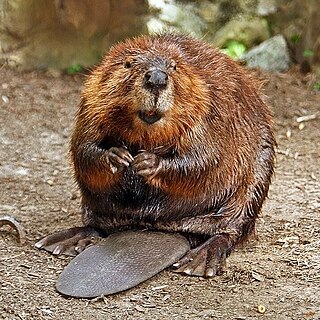
The North American beaver is one of two extant beaver species, along with the Eurasian beaver. It is native to North America and has been introduced in South America (Patagonia) and Europe. The North American beaver is one of the official national wildlife of Canada symbols and is the official state mammal of Oregon and New York. North American beavers are widespread across the continental United States, Canada, southern Alaska, and some parts of northern Mexico.

Cornus canadensis is a species of flowering plant in the dogwood family Cornaceae, native to eastern Asia and North America. Common names include Canadian dwarf cornel, Canadian bunchberry, quatre-temps, crackerberry, and creeping dogwood. Unlike its relatives, which are for the most part substantial trees and shrubs, C. canadensis is a creeping, rhizomatous perennial growing to about 20 centimetres tall.

The adjective hygrophanous refers to the color change of mushroom tissue as it loses or absorbs water, which causes the pileipellis to become more transparent when wet and opaque when dry.

The Psathyrellaceae are a family of dark-spored agarics that generally have rather soft, fragile fruiting bodies, and are characterized by black, dark brown, rarely reddish, or even pastel-colored spore prints. About 50% of species produce fruiting bodies that dissolve into ink-like ooze when the spores are mature via autodigestion. Prior to phylogenetic research based upon DNA comparisons, most of the species that autodigested were classified as Coprinaceae, which contained all of the inky-cap mushrooms. However, the type species of Coprinus, Coprinus comatus, and a few other species, were found to be more closely related to Agaricaceae. The former genus Coprinus was split between two families, and the name "Coprinaceae" became a synonym of Agaricaceae in its 21st-century phylogenetic redefinition. Note that in the 19th and early 20th centuries the family name Agaricaceae had far broader application, while in the late 20th century it had a narrower application. The family name Psathyrellaceae is based on the former Coprinaceae subfamily name Psathyrelloideae. The type genus Psathyrella consists of species that produce fruiting bodies which do not liquify via autodigestion. Psathyrella remained a polyphyletic genus until it was split into several genera including 3 new ones in 2015. Lacrymaria is another genus that does not autodigest its fruiting bodies. It is characterized by rough basidiospores and lamellar edges that exude beads of clear liquid when in prime condition, hence the Latin reference, lacryma (tears).

Psathyrella is a large genus of about 400 species, and is similar to the genera Coprinellus, Coprinopsis, Coprinus and Panaeolus, usually with a thin cap and white or yellowish white hollow stem. The caps do not self digest as do those of Coprinellus and Coprinopsis. Some also have brown spores rather than black. These fungi are often drab-colored, difficult to identify, and all members are considered inedible or worthless and so they are often overlooked. However they are quite common and can occur at times when there are few other mushrooms to be seen. The first report of a gilled mushroom fruiting underwater is Psathyrella aquatica.
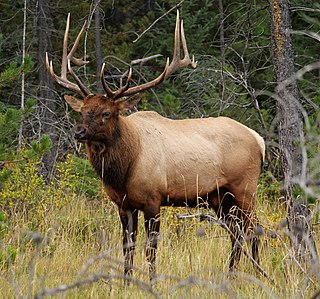
The elk, or wapiti, is the second largest species within the deer family, Cervidae, and one of the largest terrestrial mammals in its native range of North America and Central and East Asia. The word "elk" originally referred to the European variety of the moose, Alces alces, but was transferred to Cervus canadensis by North American colonists. The name "wapiti" derives from a Shawnee and Cree word meaning "white rump" for the distinctive light fur in the rear region, just like the Bighorn Sheep.

Alexander Hanchett Smith was an American mycologist known for his extensive contributions to the taxonomy and phylogeny of the higher fungi, especially the agarics.
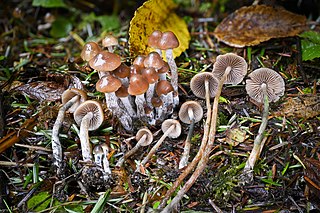
Psilocybe pelliculosa is a species of fungus in the family Hymenogastraceae. The fruit bodies, or mushrooms, have a conical brownish cap up to 2 cm in diameter atop a slender stem up to 8 cm long. It has a white partial veil that does not leave a ring on the stem. American mycologist Alexander H. Smith first described the species in 1937 as a member of the genus known today as Psathyrella; it was transferred to Psilocybe by Rolf Singer in 1958.

Psathyrella bipellis is a species of mushroom in the family Psathyrellaceae.
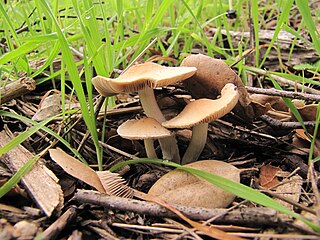
Coprinopsis uliginicola is a species of agaric fungus in the family Psathyrellaceae. It was formally described by mycologists Kent McKnight and Alexander H. Smith in 1972. It was moved into the genus Coprinopsis in 2015 by Leif Örstadius & Ellen Larsson based on DNA sequences obtained from the holotype. Found in the United States, the paratype collection was made by Smith in the Nez Perce National Forest (Idaho) in 1962. Smith noted the species to also occur in New Mexico, Utah, and Wyoming, where it grows in wet areas under brush or on decaying aspen wood.

Psathyrella longipes, the tall Psathyrella, is a species of agaric fungus in the family Psathyrellaceae and the brittlestem genus, Psathyrella. It was originally described as Hypholoma longipes by Charles Horton Peck in 1895; Alexander H. Smith transferred it to Psathyrella in 1941.
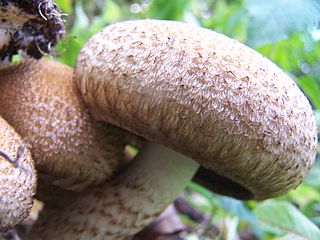
Psathyrella echiniceps is a species of agaric fungus in the family Psathyrellaceae. First described under the name Hypholoma echiniceps by George F. Atkinson in 1909, it was transferred to the genus Psathyrella by Alexander H. Smith in 1972. It is found in the US states of California, Idaho, Maryland, Michigan, New York, Ohio, Oregon, and Washington, where it grows in small groups around hardwood stumps.

Psathyrella atrospora is a species of mushroom in the family Psathyrellaceae. Found in North America, it was described as new to science in 1972 by mycologist Alexander H. Smith.

Psathyrella spadicea or Homophron spadiceum, commonly known as the chestnut brittlestem, is a species of agaric fungus in the family Psathyrellaceae. The fungus was originally described by German mycologist Jacob Christian Schäffer in 1783 as Agaricus spadiceus. Rolf Singer transferred it to the genus Psathyrella in 1951, in which it was classified in the section Spadiceae. In 2015 Örstadius & Larsson recreated the genus Homophron for a group of psathyrelloid mushrooms with no veil and with light-coloured spores, and P. spadicea was moved to the new genus.
Kenneth A. Harrison was a Canadian mycologist. He was for many years a plant pathologist at what is now the Atlantic Food and Horticulture Research Centre in Nova Scotia. After retirement, he contributed to the taxonomy of the Agaricomycotina, particularly the tooth fungi of the families Hydnaceae and Bankeraceae, in which he described several new species.

David Ross Sumstine was an American educator and mycologist.

Psathyrella corrugis, is the type species of the basidiomycete fungus genus Psathyrella and family Psathyrellaceae. Originally described from Europe as Agaricus corrugis, the species is considered non-toxic but lacking in flesh, flavor and texture. It is inedible.

Candolleomyces candolleanus is mushroom in the family Psathyrellaceae. It is commonly found growing in small groups around stumps and tree roots on lawns and pastures in Europe and North America. In 2014, it was reported from Iraq. The coloring varies between white and golden brown. The cap is tan when young, growing to 2–8 cm (1–3 in) in diameter, initially conical, later becoming rounded and finally with upturned margins in maturity. The cap margin is irregular and radially asymmetrical—a defining characteristic of this species. It can retain veil fragments on the edge and center. The white stalk is 4–10 cm (1.5–4 in) tall and 3–7 mm wide. The spore print is purple-brown, while spores are smooth and elliptical, measuring 6.5–8 by 4–5 µm. The specific epithet candolleanus honors Swiss botanist Augustin Pyramus de Candolle.
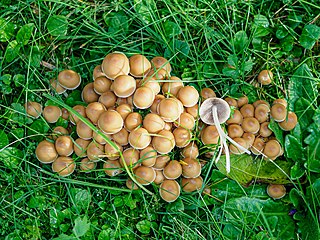
Britzelmayria multipedata is a species of mushroom producing fungus in the family Psathyrellaceae. It is commonly known as the clustered brittlestem.
















